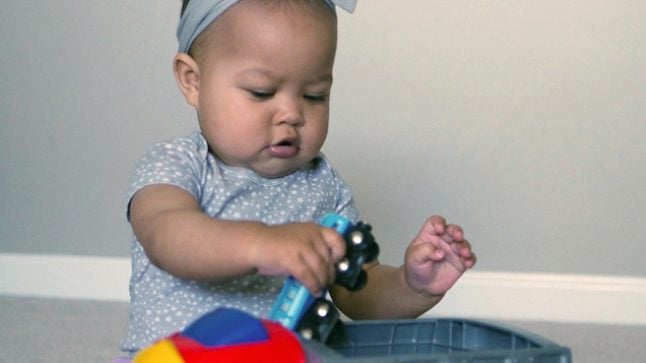Series: Focus on the Child
Math Activities for Infants and Toddlers are Everyday Explorations

Long before they can talk or explain, babies are thinking logically and exploring ordinary everyday objects, sensations, and experiences that are new to them. They are trying to find out more about questions such as:
- “What is this?”
- “How does it work?” and
- “How is it the same and different from something I already know?”
This kind of thinking and problem solving when participating in math activities for infants and toddlers goes on all the time — it is so natural and commonplace that we often overlook it or dismiss it as “just play.” However, encouraging and celebrating their explorations and discoveries is a highly effective way to help those little brains grow. Instead of looking for expensive learning toys, look to everyday explorations.
For example, take this one-minute video of an 11-month-old playing with the magnets at the bottom of the family fridge. Watch for observable actions and expressions that indicate any of the following:
- the child is engaged — that she finds what she is doing interesting (consider actions, facial expression, gaze, etc.)
- the child’s actions are intentional, not just random
- the child is problem-solving, that is, puzzled about something and testing out some possibilities
Watch the video again. This time, focus on the way those general approaches to learning might be considered mathematical thinking, related to the Precursor Math Concepts of Attribute, Comparison, Change and Pattern.
What do you notice that suggests the child is
- Intentionally exploring how the attributes of the front of the magnet compare to those of the back and how the attributes of the board book might compare to the fridge surface?
- Puzzling about change as she finds a different result when the magnet is put on the book instead of the refrigerator, even though both surfaces have many of the same observable attributes?
- Expecting a pattern, that is, assuming that when the things called “magnets” are put on a hard, shiny surfaces, they will stick rather than slide off?
- Encouraged by her father who is taking the video to explore and discover?
The father doesn’t try to tell the child what to do but supports and celebrates her discoveries by asking open-ended questions in an interested tone of voice. Letting young ones figure out everyday real life situations for themselves is how to nurture their mathematical thinking. Math activities for infants and toddlers naturally follow their interest in exploring What is bigger? and Which has more? and How are these the same and different? These inquiries as well as all kinds of questions about spatial relationships, sequence, and regularity help infants and toddlers make sense of the world with math.